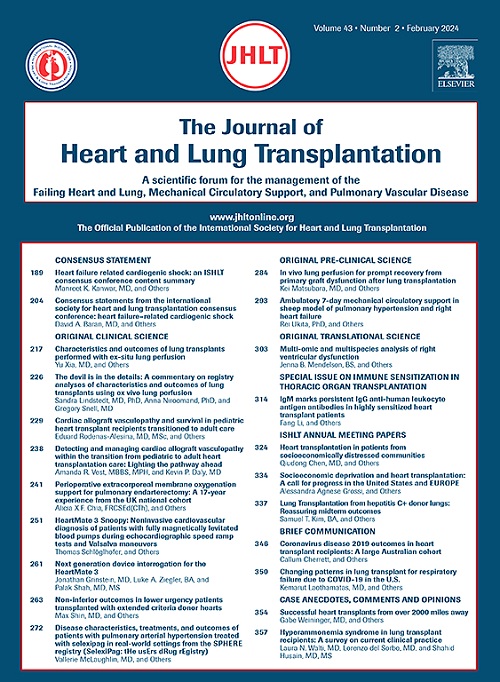慢性肺异体移植功能障碍中的局部移植物内体液免疫反应。
IF 6
1区 医学
Q1 CARDIAC & CARDIOVASCULAR SYSTEMS
引用次数: 0
摘要
导言:供体人类白细胞抗原(HLA)特异性抗体(DSA)和非 HLA 抗体可造成异体移植损伤,可能导致肺移植(LTx)后慢性肺异体移植功能障碍(CLAD)。目前仍不清楚这些抗体是在移植物局部产生的,还是仅来源于循环中的浆细胞。我们假设在 CLAD 肺中会产生 DSA 和非 HLA 抗体:方法:前瞻性地收集了 15 名接受再 LTx 或尸检的 CLAD 患者的肺组织。将 0.3 克新鲜肺组织在无脂多糖或有 CD40L 的情况下培养 4 天,取肺培养上清液(LCS)。从 0.3 克冷冻肺组织中提取蛋白质洗脱液。DSA 和非 HLA 抗体的平均荧光强度 (MFI) 分别通过 Luminex 和抗原芯片进行测量:结果:肺分离时血清中含有DSA的4名患者的LCS均为DSA阳性,用CD40L刺激肺组织后测得的DSA水平更高(CD40L+LCS)。其中,只有 2 人的肺洗脱液中可检测到 DSA。CD40L+LCS 中非 HLA 抗体的 MFI 与肺洗脱液中的相关,但与血清中的不相关。流式细胞术显示,CD40L+LCS呈DSA阳性(4人)或非HLA抗体阳性(6人)的患者,其肺部活化B细胞的频率高于本地抗体较低的患者(5人)。免疫荧光染色显示,带有局部抗体的CLAD肺淋巴细胞聚集体含有更多的IgG+浆细胞,IL-21的表达量也更大:结论:我们的研究表明,富含活化 B 细胞的肺异体移植物可产生 DSA 和非 HLA 抗体。本文章由计算机程序翻译,如有差异,请以英文原文为准。
Local intragraft humoral immune responses in chronic lung allograft dysfunction
Background
Donor human leukocyte antigen (HLA)-specific antibodies (DSA) and non-HLA antibodies can cause allograft injury, possibly leading to chronic lung allograft dysfunction (CLAD) after lung transplantation. It remains unclear whether these antibodies are produced locally in the graft or derived solely from circulation. We hypothesized that DSA and non-HLA antibodies are produced in CLAD lungs.
Methods
Lung tissue was prospectively collected from 15 CLAD patients undergoing retransplantation or autopsy. 0.3 g of fresh lung tissue was cultured for 4 days without or with lipopolysaccharide or CD40L: lung culture supernatant (LCS) was sampled. Protein eluate was obtained from 0.3 g of frozen lung tissue. The mean fluorescence intensity (MFI) of DSA and non-HLA antibodies was measured by Luminex and antigen microarray, respectively.
Results
LCS from all 4 patients who had serum DSA at lung isolation were positive for DSA, with higher levels measured after CD40L stimulation (CD40L+LCS). Of these, only 2 had detectable DSA in lung eluate. MFI of non-HLA antibodies from CD40L+LCS correlated with those from lung eluate but not with those from sera. Flow cytometry showed higher frequencies of activated lung B cells in patients whose CD40L+LCS was positive for DSA (n = 4) or high non-HLA antibodies (n = 6) compared to those with low local antibodies (n = 5). Immunofluorescence staining showed CLAD lung lymphoid aggregates with local antibodies contained larger numbers of IgG+ plasma cells and greater IL-21 expression.
Conclusions
We show that DSA and non-HLA antibodies can be produced within activated B cell-rich lung allografts.
求助全文
通过发布文献求助,成功后即可免费获取论文全文。
去求助
来源期刊
CiteScore
10.10
自引率
6.70%
发文量
1667
审稿时长
69 days
期刊介绍:
The Journal of Heart and Lung Transplantation, the official publication of the International Society for Heart and Lung Transplantation, brings readers essential scholarly and timely information in the field of cardio-pulmonary transplantation, mechanical and biological support of the failing heart, advanced lung disease (including pulmonary vascular disease) and cell replacement therapy. Importantly, the journal also serves as a medium of communication of pre-clinical sciences in all these rapidly expanding areas.

 求助内容:
求助内容: 应助结果提醒方式:
应助结果提醒方式:


